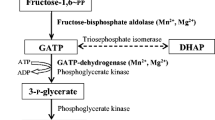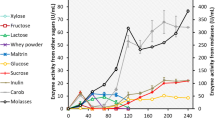Abstract
In order to find an alternative for commercial inulinase, a strain XL01 identified as Penicillium sp. was screened for inulinase production. The broth after cultivated was centrifuged, filtered, and used as crude enzyme for the following saccharification. At pH 5.0 and 50 °C, the crude enzyme released 84.9 g/L fructose and 20.7 g/L glucose from 120 g/L inulin in 72 h. In addition, simultaneous saccharification and fermentation of chicory flour for d-lactic acid production was carried out using the self-produced crude inulinase and Lactobacillus bulgaricus CGMCC 1.6970. A high d-lactic acid titer and productivity of 122.0 g/L and 1.69 g/(L h) was achieved from 120 g/L chicory flour in 72 h. The simplicity for inulinase production and the high efficiency for d-lactic acid fermentation provide a perspective and profitable industrial biotechnology for utilization of the inulin-rich biomass.





Similar content being viewed by others

References
Yu, H., Zhang, M., Ouyang, J., & Shen, Y. (2014). Comparative study on four chemical pretreatment methods for an efficient saccharification of corn stover. Energy & Fuels, 28(7), 4282–4287.
Wang, L., Xue, Z., Zhao, B., Yu, B., Xu, P., & Ma, Y. (2013). Jerusalem artichoke powder: a useful material in producing high-optical-purity L-lactate using an efficient sugar-utilizing thermophilic Bacillus coagulans strain. Bioresource Technology, 130, 174–180.
Chi, Z. M., Zhang, T., Cao, T. S., Liu, X. Y., Cui, W., & Zhao, C. H. (2011). Biotechnological potential of inulin for bioprocesses. Bioresource Technology, 102(6), 4295–4303.
Dao, T. H., Zhang, J., & Bao, J. (2013). Characterization of inulin hydrolyzing enzyme(s) in commercial glucoamylases and its application in lactic acid production from Jerusalem artichoke tubers (Jat). Bioresource Technology, 148, 157–162.
Li, L., Chen, C., Li, K., Wang, Y., Gao, C., Ma, C., & Xu, P. (2014). Efficient simultaneous saccharification and fermentation of inulin to 2,3-butanediol by thermophilic Bacillus licheniformis ATCC 14580. Applied and Environmental Microbiology, 80(20), 6458–6464.
Wang, S. A., & Li, F. L. (2013). Invertase SUC2 is the key hydrolase for inulin degradation in Saccharomyces cerevisiae. Applied and Environmental Microbiology, 79(1), 403–406.
Shi, N., Mao, W., He, X., Chi, Z., Chi, Z., & Liu, G. (2017). Co-expression of exo-inulinase and endo-inulinase genes in the oleaginous yeast Yarrowia lipolytica for efficient single cell oil production from inulin. Applied Biochemistry and Biotechnology. https://doi.org/10.1007/s12010-017-2659-1.
Cao, C., Zhang, L., Gao, J., Xu, H., Xue, F., Huang, W., & Li, Y. (2017). Research on the solid state fermentation of Jerusalem artichoke pomace for producing R, R-2, 3-butanediol by Paenibacillus polymyxa ZJ-9. Applied Biochemistry and Biotechnology, 182(2), 687–696.
Park, J. M., Oh, B. R., Kang, I. Y., Heo, S. Y., Seo, J. W., Park, S. M., Hong, W. K., & Kim, C. H. (2017). Enhancement of 2, 3-butanediol production from Jerusalem artichoke tuber extract by a recombinant Bacillus sp. strain BRC1 with increased inulinase activity. Journal of Industrial Microbiology & Biotechnology, 44(7), 1107–1113.
Petrova, P., Velikova, P., Popova, L., & Petrov, K. (2015). Direct conversion of chicory flour into L(+)-lactic acid by the highly effective inulinase producer Lactobacillus paracasei DSM 23505. Bioresource Technology, 186, 329–333.
Wang, J., Jin, Z., Jiang, B., & Adamu, A. (2003). Production and separation of exo-and endoinulinase from Aspergillus ficuum. Process Biochemistry, 39, 5–11.
Mansouri, S., Houbraken, J., Samson, R., Frisvad, J., Christensen, M., Tuthill, D., et al. (2013). Penicillium subrubescens, a new species efficiently producing inulinase. Antonie Van Leeuwenhoek, 103(6), 1343–1357.
Leelaram, S., Sivanesh, N., Surianarayanan, M., Deepa, P., & Balaje, S. A. (2016). Effect of feeding strategies on inulinase production analyzed in a biocalorimeter. Process Biochemistry, 51(6), 692–703.
Gao, C., Ma, C., & Xu, P. (2011). Biotechnological routes based on lactic acid production from biomass. Biotechnology Advances, 29(6), 930–939.
Xu, Q., Zang, Y., Zhou, J., Liu, P., Li, X., Yong, Q., & Ouyang, J. (2016). Highly efficient production of D-lactic acid from chicory-derived inulin by Lactobacillus bulgaricus. Bioprocess and Biosystems Engineering, 39(11), 1749–1757.
Smit, E., Leeflang, P., Glandorf, B., van Elsas, J. D., & Wernars, K. (1999). Analysis of fungal diversity in the wheat rhizosphere by sequencing of cloned PCR-amplified genes encoding 18S rRNA and temperature gradient gel electrophoresis. Applied and Environmental Microbiology, 65, 2614–2621, 6.
Xu, Y., Zheng, Z., Xu, Q., Yong, Q., & Ouyang, J. (2016). Efficient conversion of inulin to inulooligosaccharides through endoinulinase from Aspergillus niger. Journal of Agricultural and Food Chemistry, 64(12), 2612–2618.
Rawat, H. K., Chand Jain, S., & Kango, N. (2015). Production and properties of inulinase from Penicillium sp. NFCC 2768 grown on inulin-rich vegetal infusions. Biocatalysis and Biotransformation, 33(1), 61–68.
Singh, R. S., Chauhan, K., Singh, J., Pandey, A., & Larroche, C. (2018). Solid-state fermentation of carrot pomace for the production of inulinase by Penicillium oxalicum BGPUP-4. Food Technology and Biotechnology, 56(1).
Flores-Gallegos, A. C., Morlett-Chávez, J. A., Aguilar, C. N., Riutort, M., & Rodríguez-Herrera, R. (2015). Gene encoding inulinase isolated from Penicillium citrinum ESS and its molecular phylogeny. Applied Biochemistry and Biotechnology, 175(3), 1358–1370.
Kango, N., & Jain, S. C. (2011). Production and properties of microbial inulinases: recent advances. Food Biotechnology, 25(3), 165–212.
Acknowledgments
This study was supported by the National Natural Science Foundation of China (51776099, 31300487), the Key Research and Development Program of Jiangsu Province of China (BF2015007). The authors are also grateful to the Priority Academic Program Development of Jiangsu Higher Education Institutions (PAPD).
Author information
Authors and Affiliations
Corresponding author
Ethics declarations
Conflict of Interest
The authors declare that they have no conflict of interest.
Rights and permissions
About this article
Cite this article
Zheng, Z., Xu, Q., Liu, P. et al. Enhanced Inulin Saccharification by Self-Produced Inulinase from a Newly Isolated Penicillium sp. and its Application in d-Lactic Acid Production. Appl Biochem Biotechnol 186, 122–131 (2018). https://doi.org/10.1007/s12010-018-2730-6
Received:
Accepted:
Published:
Issue Date:
DOI: https://doi.org/10.1007/s12010-018-2730-6



